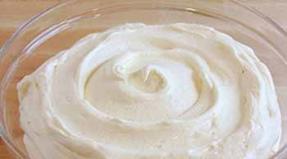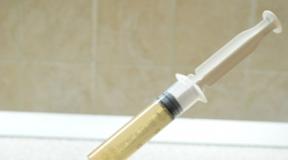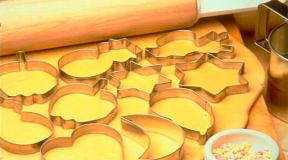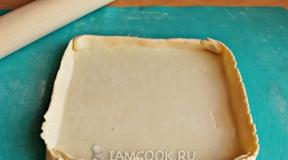Contrast showers and other ways to clean squid without the hassle. Chef's Tips: How to Peel Squid Quickly
Why are sea mollusks useful?
In general, if you have this product from the category of "rare guest" in your diet, urgently correct yourself: squid meat contains iron and potassium, iodine, zinc and selenium.
In him no cholesterol at all, but a lot of protein.
Caloric content is relatively low - 100 kcal per 100 grams(The amount of kcal varies depending on the cooking method).
Dishes with squid are a high-quality "building" material for muscle tissue, which has a general strengthening, anti-sclerotic, vasotonic effect.
Eating this sea mollusk removes toxins and salts of heavy metals, improves digestion and supports the endocrine system (especially the thyroid gland).
Usually, this product is rarely used by those housewives who do not know how to peel the squid, which part to eat, or some other dish. There are, of course, difficulties, but their minimum! It is worth doing everything once and then all that remains is to wonder why he could not do this before!
How to peel squid from film: basic methods
There are 3 main ways to cope with the film on the carcass - peel without heat treatment and apply blanching, pre-boiling.
Cold method
 Take a fresh or quick-frozen carcass in your hand and pull off the film with a "stocking".
Take a fresh or quick-frozen carcass in your hand and pull off the film with a "stocking".
If the film is not removed with a sudden movement, it can be peeled off little by little, pulling off with smooth movements.
After removing the film, the insides of the sea animal and the chord (chitinous resemblance of the spine) are removed.
The carcass for this method must be headless.
Hot method
If the method of freezing is unknown, especially if the squid thawed and froze again during storage, or was covered with ice, or was crumpled and deformed, then the "stocking" cleaning method does not suit him.
Such shellfish should be placed in a heat-resistant colander and immersed in boiling water for 7-10 seconds. Then take it out and immediately immerse it in ice water. In most cases, the film will wrinkle and peel off on its own. Sometimes you will need to do a little work with your hands and remove its remnants from the carcass.
Cleaning cooked squid
 If the squid was boiled in a film, then to remove it, you need to slightly cool the carcass.
If the squid was boiled in a film, then to remove it, you need to slightly cool the carcass.
You can then use a new soft kitchen brush.
It is enough to rub the carcass a little, and the film will collect into balls and peel off.
Experienced cooks do not like to use this method - the taste of the finished seafood deteriorates.
How to peel fresh squid
If you are lucky enough to purchase a freshly caught shellfish, then you need to clean it immediately. The process diagram is simple:
- We hold the whole carcass well with one hand, with the other tightly grasp the head immediately behind the eyes and confidently pull it out - in one hand the body with fins remains, and in the other - the head with tentacles and entrails:
- cut off the tentacles, discard the rest (eyes, entrails, the longest "mustache"). Carefully with the beak - it may remain with tentacles, remove it, they do not eat it;
- we free the carcass from the remaining viscera and the chitinous core - we just pull it out by hand;
- shrink the film under running water.
We clean whole frozen carcasses
 To clean the squid, you need to defrost it.
To clean the squid, you need to defrost it.
The best defrosting method is gradual, gentle.
For this, the carcass from the freezer is transferred to the refrigerator compartment.
When it thaws, you need to move it to room temperature and keep it until it is fully restored to normal.
It is unacceptable to defrost this seafood by steam, in water or put close to heating devices. Such "barbaric" methods irreversibly degrade the taste, smell and structure of squid meat.
We clean in the same way as freshly caught. After - rinse the carcasses with water and lower them into boiling water.
The period of stay in boiling water depends on further actions.
If, after scalding, it is immersed in ice water, then a 10-second blanching is enough. Carcasses taken out of cold water can be easily cleaned by hand. This method is reliable, but squid peeled with it is not as tasty.
If the squid will be cleaned immediately after removing it from the boiling water, then you need to keep it in the water for about a minute. The film is carefully cleaned with a brush. The meat of the squid peeled in this way is juicier after cooking.
The easiest and fastest way to clean
The frozen carcasses should be put in a bowl, poured over with boiling water for a couple of minutes, then put under a stream of cold water and cleaned with hands from the film, chord and viscera.
This method is really quick and easy. Its only drawback is that the squid become less juicy and aromatic, they become tough.
You can use such a "shock" method only when there is an acute shortage of time for gentle defrosting.
It is very difficult to find a fresh carcass in a city, and therefore you have to be content with frozen.
- Carcasses should be evenly frozen, not frozen to each other, but freely separate from one another. When shaken, two or more carcasses emit a dull thud.
- The carcass can only be white. A yellowish color indicates a violation of storage conditions.
- The smaller the carcass, the younger the animal, which means that its meat is more tender.
Most often, squid is boiled with roots and spices as an independent snack dish; fried with onion rings under a lid, stewed with onions and garlic in butter.
Useful video
I propose to see how to peel calamari from the film easily and quickly:
For a long time people have been using seafood for food, they are tasty and nutritious. Squids are one of the most affordable and healthy seafood. Squid are rich in vitamins, microelements, they contain a lot of iodine, phosphorus and magnesium. They are also rich in valuable protein, which is easily absorbed and stimulates the production of gastric juice. To prepare dishes with squid, you need to know how to properly clean them from the film. It is also important to cook them properly to keep the meat tender and juicy.
Before cooking, the squid should be peeled from the film. To do this, pour boiling water over the carcasses for a few seconds, the thin skin should come off by itself. But a problem may arise - after boiling water, the squids are already half cooked, and they are easy to digest. In this case, use a different method to remove the film from the squid. Take the frozen product out of the refrigerator and defrost it in the air. Press the defrosted carcass with your hand and remove the skin, gently prying its edge with your fingernail. Usually the skin from the squid comes off completely, but if it was thawed and frozen again, then it may not come off. You also need to remove the skin from the squid wings and remove the chitinous plates from the inside before cooking. Depending on the food you plan to cook, there are several easy ways to cook frozen squid. For example, to prepare a salad with squid, it is enough to pour boiling water over the carcass and hold it for 5 minutes. Then remove the skin from it, cut into rings and sprinkle with lemon juice. For some dishes, the squid should be boiled for a little longer using spices. To cook squid correctly, you will need:- Water - 1 l;
- Black peppercorns;
- Bay leaf - 2 pcs;
- Salt;
- Squid carcasses - 2 pcs.
A large number of dishes are prepared with squid, in addition to the famous salad, squid is put in sandwiches, in pizza, zrazy is made, stuffed with vegetables, and snacks are prepared. Properly peeled and cooked, squid is a delicacy and delicate delicacy for true gourmets.
Seafood is a very healthy food rich in proteins, vitamins and microelements. Cuisines from different nations of the world combine recipes with different marine life. The cheapest product is squid. However, despite the fact that many people love him, there is a lot of trouble with him. Many housewives are in no hurry to cook various dishes with it due to the fact that they do not know how to clean it properly. But this is not difficult. Today we will talk about how to peel squid.
How to choose the right squid?
Before you understand how to clean the squid from the film, you need to choose and buy them correctly. Freshly caught squids are perfectly cleaned. In this case, the film, which is located on the outside and inside of the seabed dweller, is removed like a stocking, very easily. However, fresh molluscs come across the inhabitants of the sea coasts. Most people buy frozen food.
Despite the fact that you are purchasing frozen squid, you should pay attention to the purchase. The key to successful preparation and pre-cleaning is the correct storage and transportation conditions for marine life. So, defrosting and re-freezing of this product is not allowed.
Important! If you notice that this rule is not observed in any store, or the squids have already thawed, but they will be frozen again, you should refuse this purchase and buy it elsewhere.
Rules for the successful purchase of squid:
- Frozen carcasses should be separate from each other, as if glazed in a small amount of ice. If you notice that several shellfish are attached to each other, this means that the product has previously been defrosted and re-frozen. You shouldn't buy such seafood.
- If you want to buy a quality product, you should give preference to those with a white carcass without blotches of blue and pink. Spots of other shades indicate that the color of the clam skin was absorbed into the carcass during the thawing process.
Buying low-quality seafood leads not only to poor cleaning of the carcass, but also to a distortion of taste. In addition, poor quality seafood can harm your health.
Important! Many housewives buy seafood carcasses painted pink or light blue. However, this should not be done - old squids have this color. They take a long time to cook and their taste is several times worse than that of young shellfish.
How to quickly remove the film from squid?
There are several options to remove the film from the squid. Each housewife, having tried each of them, will be able to choose the most suitable and convenient technology for herself, and subsequently she will spend a small amount of time cleaning the carcasses.
Important! Before peeling the carcass itself, many people have a question about why, at all, create these difficulties and remove the film? The fact is that in this transparent film the meat shrinks several times and becomes very tough and unsuitable for eating.
Cold way
One of the most common ways to remove film from squid is to use the cold method. This technique is only suitable for freshly caught or properly frozen seafood.
Carcass cleaning sequence:
- We take the carcass and gently pry off the film from one edge.
- It is necessary to remove the film from all sides gradually, as if removing a stocking.
- We clean the inner cavity - the chord.
The carcass is cleaned.
Important! This method is common, but it is better to use it on freshly caught squid, as you cannot be sure of the correct method of freezing the product.

Hot way
For frozen seafood, the hot method is the most common method for cleaning squid. In it, seafood carcasses are subjected to short-term heat treatment.
The procedure for cleaning a carcass with a head and tentacles with a hot method:
- We defrost the carcasses. To do this, put the frozen seafood in a bowl and put it in the refrigerator or on the table. We expect complete defrosting.
- By pulling on the head of the carcass, you cleanse the insides of the seafood.
- Cut off the tentacles at eye level.
- At this stage, removes the beak.
Important! It is quite hard, so you need to do it carefully, and then make sure that there are no fragments of solid particles.
- There is a transparent spine inside the carcass. It is a little hard, so it will not be difficult to find it. We delete it.
- Only after completing all the previous steps is the squid ready to clean the film.
- We wash the carcasses thoroughly in plenty of water. We wash the insides and dry them with dry paper towels.
- We take a deep saucepan, pour boiling water into it and immediately lower the carcass. We leave for two minutes. During this period of time, the film will go away, and the meat will not cook.
- Hot water curls the film. As a result, under the pressure of running water, you can easily solve the problem of how to clean squid.
Cleaning with a contrast shower
Another common way to remove film from squid is to apply a contrasting water temperature. Its essence is very simple:
- To do this, you need to clean and rinse the carcasses.
- Put the seafood in a bowl, pour boiling water over it and immediately transfer it to a bowl of ice water and a small amount of ice cubes.
Thanks to this “contrasting shower” for seafood, the film will come off, the meat will not cook and the problem of cleaning will be solved.
Cleaning boiled squid
When considering all the ways how to clean frozen squid, it is worth paying attention to the method of cleaning boiled carcasses. In this case, they are pre-cooked, and only then they are freed from the film. At the time of cooking, the film can burst and collect into balls. Then it must be cleaned with a kitchen brush.
Important! Sometimes you can remove the film from a boiled carcass using the "stocking" method. Either way, removing this piece of seafood is easy enough.
Cooking seafood
You have already decided how to clean the squid from the film, it is worth moving on to cooking them. The heat treatment process, as well as cleaning, raises a large number of questions for many housewives, and not every girl knows the cooking method. However, this is not difficult - now we will tell you how to do it.
Important! Cooking carcasses is not at all difficult. However, you should follow all the rules and always look at the clock. If you overcook seafood, it will become tough, rubbery and tasteless. It is very simple to determine whether you have overcooked squids or not: the spoiled product decreases several times in size.
Variety and affordability in terms of price characteristics are the main advantages of seafood. In addition, all such products, including squid, have a high content of various vitamins and microelements. And the taste of seafood dishes is simply delicious.
The problem with cooking squid is that not all cooks can clean them correctly and quickly. This seafood, however, is very tender, and the handling should be appropriate. So how to peel and boil squid?
What are the benefits of squid for the body?
Almost any seafood is very useful for humans. These foods are high in protein and amino acids. Squid is also no exception, and the additional advantage of the product is its easy digestibility of proteins and richness in vitamin B. And if it were not for the problem of how to peel squid, it is likely that this seafood would appear on the table of any home with regular consistency.
There is no doubt that squid surpasses in its benefits even more familiar products - meat and fish. At the same time, its calorie content is minimal (no more than 86 kcal per 100 g), which makes it possible to successfully introduce the product into the menu of many diets.

Taurine is also among the elements found in squid meat. With the regular use of seafood, there is a significant improvement in memory and normalization of the digestive tract, blood pressure returns to normal, and the thyroid gland improves.
The benefits for children should not be underestimated either. Squid is perfect for feeding babies from 3 years old. Due to its high iodine content, it provides the growing body with the necessary element in the required amount.
Selection of quality seafood
Canned and frozen squid carcasses can usually be found on supermarket shelves. For those who live close to the places where this type of seafood is mined, it is better to pay attention to fresh seafood.
If the choice is only between canned and frozen options, then in the first case it is recommended to look at the expiration date and the integrity of the jar. The second option must be carefully checked. It is imperative to evaluate the appearance of the carcass, its color and separability from others. If squids stick together into a lump - this is a reason to be on the alert. This means that the seafood has already been thawed and re-frozen, and this can spoil the taste of the product in the future. In this case, the meat may taste noticeably bitter after cooking.

The film on frozen seafood can range from gray to purple, but the meat should remain white. A change in the color of the meat signals a re-freezing. After such manipulations, the taste of the finished dish will not differ in the best taste properties. So, when buying seafood, you should be extremely careful.
Methods for cleaning frozen carcasses
Before proceeding directly to the preparation of the dish, you should figure out how to peel the squid. Here are two ways to prepare for cleaning:
- pour boiling water over seafood (does not require defrosting);
- defrost the carcass, pour over boiling water and immediately pour over with ice water.
At the same time, do not forget that in addition to the gray film, there is also a transparent one. Its removal is mandatory. It is not at all difficult to quickly clean squid from such a film. It is enough just to pick up the edge of the shell with a knife or fingernail and carefully, millimeter by millimeter, pull it off like a stocking.

In addition, we must not forget about the mandatory removal of squid entrails. It's very easy with frozen carcasses. You need to either turn the carcass "inside out", or just stick your hand into it, feel the insides themselves and the hard chord, and then pull it towards you. This "content" is taken out without much effort. After these manipulations, you can start cooking squid dishes.
Method for cleaning fresh seafood
Those who managed to get a fresh carcass need to be patient. To clean squid at home, you will have to make a little more effort than when processing a frozen product.
Usually, a fresh product is presented to the buyer in its entirety, that is, with its head and entrails. The head should not be eaten; when processing the carcass, it should be cut off and discarded. You only need to leave the "mantle", "wings" and tentacles. Only these parts of the carcass are usually suitable for cooking and further consumption.
You can clean the squid from the film using one of the methods used for frozen carcasses. But there is also a nuance: it will be much better to tear off the shell without using temperature changes. In this case, the taste of the finished dish will be richer. To remove the film, you need to pick up both types of casings and carefully pull them off the carcass. With a certain skill, some chefs do it in one fell swoop.

Removing the entrails is exactly the same as in the case of a frozen carcass.
How to prepare this product?
There are a lot of options for cooking squid dishes. This seafood, by the way, can not only be boiled, but also fried. Quite good squid in salads, stuffed, and also in appetizers.
Squids are usually cooked as follows: peppercorns, bay leaves and salt are placed in boiling water. If desired, you can add other spices, such as cloves. After everything has been laid, one squid carcass is lowered into the pan for 15 seconds. After removing it, the second is laid at the same time, and so on.
You should not cook the squid for longer. Many recipes specify a time of 3 to 5 minutes. This is completely wrong, for such a period of time the squid meat will become "rubbery" and lose its rich bouquet of taste.
The only option for long-term cooking of this product may be the case when the squid is cooked with sauce or as part of any dish (hodgepodge, stuffed product). Here you have to rely on the recommendations in the recipe itself.

Some people use a black tea bag or half a lemon as a condiment for cooking. This decision will have a positive effect on the taste of the future dish. Lemon is generally used in cooking seafood such as shrimp. It gives the seafood a refined taste and aroma.

Finally
The benefits of seafood for the human body are undeniable. For children and the elderly, a seafood-based diet is the best option. Replenishment of the content of trace elements, including iodine, is necessary for everyone.
Cooking squid is not as difficult as some housewives think. Dishes made from this seafood can and should be tender and juicy. You just need to strictly observe all the correct processing of the product and its direct preparation. The final result in the form of the dish itself depends on this.
The variety of squid recipes is truly impressive. You can choose a dish for every taste, or even turn on your imagination and cook something new. The main thing is to follow the recommendations.
Do you want to pamper your household with delicious squid meat? But you don't know how to peel squid? Well, in that case, our instructions for cleaning squid will come in handy. Knowing how to peel squid can be a funky treat at home.
Many leading nutritionists recommend squid meat. Seafood must be in the human diet. If we are talking specifically about squid, it should be noted that this meat goes well with vegetables and cereals. That is, by learning how to peel squid, you can prepare a variety of dishes for your family. Moreover, it can be hot dishes or simple but very tasty cold snacks. Therefore, it is extremely important to know how you can clean the squid from the film.
The right choice of squid is the key to a delicious dish
Before we talk about how to peel squid, you should learn how to choose the right one.
If the squid is fresh, say, literally caught out of water, it can be cleaned simply, quickly, without any difficulties. The film that covers the carcass is removed entirely. Therefore, if you want to enjoy such a privilege, it makes sense to live on the coast. Then you will have the opportunity to buy squid from the locals.
What gifts of nature are waiting for us in stores and hypermarkets? As a rule, these are frozen seafood, in particular - squid carcasses with tentacles. And we can only guess how many times this product has been defrosted and re-frozen. Unfortunately, it is the repeated freezing that affects the taste of the squid and the quality of its cleaning. Although even a frozen product can be successfully cleaned if the standards for its storage have been followed.
If you intend to purchase exceptionally high quality squid, you will need to pay attention to the fact that the shellfish carcasses do not stick together. If you see that there are squids in front of you, which are literally frozen one to one, it is better to refuse to buy such a product, especially if the first attempt to separate the carcasses was unsuccessful. This is the first sign that you have squid in front of you that "survived" the re-freezing. The next no less important point to pay attention to: the meat of really good squid should be white. If the squid in front of you is bluish, pink in color, it means that the meat was saturated with the color of the skin when the thawing process took place. And this is another confirmation that this is a low-quality product. And during cleaning it will be difficult for you to remove the film.
These two tips will help save you from a bad purchase, from an excruciatingly long cleaning. And it is not a fact that the squid will be safe for the stomach.
The most common mistake is that many people choose large squid carcasses, richly colored. As you may have guessed, we are talking about old shellfish that can be unsuitable for cooking. Plus, they're incredibly difficult to clean. For the sake of experiment, of course, you can try to purchase white fresh squid meat and carcasses, painted in a bright color. Your own experience will show you where a quality product is, and which is better to never buy again.
Any gourmet will say that the meat of lightly colored small squid is an indescribable yummy. Such mollusks have more tasty and tender meat.

Squid: how to peel them
All the rules for cleaning squid assume the rapid elimination of the film.
How to quickly remove the film from squid? How can you get rid of films? This question worries many hostesses. Today, there are 4 ways to get rid of the film on squid meat. Some of them are highly efficient. The choice is yours. Test different methods and choose the one that will spend the least amount of time peeling squid from the film.
Many people wonder: why cleanse squid from films, transparent and colored? Firstly, it is an opportunity to get especially tender meat. Alas, during heat treatment, the film (transparent) can become incredibly tough. Plus, carcasses are often reduced in volume. Such metamorphoses occur due to the presence of this film. So, now you understand that it is imperative to get rid of the film. And you need to do it correctly and quickly.
We offer the following methods of cleaning squid for your choice:
- Cooking. Many inexperienced hostesses are interested in whether it is possible to peel squids when they are already boiled? As it turns out, you can also peel those squids that have already been cooked. That is, you cook unpeeled shellfish carcasses, and peel them after they are ready. It is enough to cool a little carcass. It will take a few seconds for the film to be removed with a solid stocking. When, under the influence of excessively hot water, the skin on the squid cracks, curls, you will see small balls in place of the curled film. You can get rid of the film with a special soft brush: rub it over the surface of the mollusk - and the film will clean itself. The presented method is popular when you need to prepare a salad.
- Hot cleaning. If we are talking about a frozen product that has probably been frozen several times, you cannot do without heat treatment. So, you will need to defrost non-decapitated carcasses, whole squids, including tentacles, and the head. In this case, you need to defrost it naturally, or by steam, or at room temperature. When the squid has melted, you will need to gently pull on the head and remove any entrails that are present. Then take a knife and cut off the tentacles (approximately at eye level). It is important to understand and remember that the beak, which is hidden between the tentacles, cannot be eaten. Even sperm whales cannot digest it, let alone a human stomach. Therefore, the beak must be removed immediately. In this case, you should be especially careful so that the debris does not get into the food. Then you will need to remove the flexible spine. It resembles a narrow voice of colorless plastic, which is easily felt in ink, so you can easily find the spine. And so, you just have to remove the film: for this you will need to rinse the squid meat under running water, dry it with napkins, place it in boiling water for a couple of minutes, when the pulp separates from the skin, it will be easy to get rid of the film, the film will curl itself, you will have to get the still uncooked mollusk, cool it and get rid of the layers of the film under a stream of cold water (it usually bursts during the heat treatment). By performing such a manipulation, you will quickly and effectively clean the squid, get rid of the film.
- Cold cleaning from hard films. This method does not involve thermal effects, it is suitable for both fresh and frozen products. Take the headless carcass, slowly and carefully separate the thin film and calmly pull it off. This will remove all the film, leaving something like a "stocking" in your hand. After getting rid of the unpleasant film, you just have to peel the squid from the skin, remove the notochord and internal organs. As you can see for yourself, the method is clear and simple, does not require any complex devices and conditions.
- Contrast cleaning. This simple method allows you to get rid of hard films very quickly. You can peel frozen squids in minutes. You need to cook 2 deep pots, put the squid carcasses without giblets into one, and pour ice water into the second. Once you have scalded the clams with boiling water, then quickly place them in a pot of cold water. So you will not cook the meat, it will make it easier to peel the carcass. When the film bursts, you just need to remove it manually. Then it remains to discard the peeled squid in a colander or simply dry it with a paper towel. This way you get rid of excess fluid.

So, you know how to peel squid. What is the best way to choose? Only your personal experience can help here. You can try several methods and choose the one that turns out to be the most effective, which will quickly help you solve the problem. In fact, cleaning squid from films is an easily solvable task. The main thing is to approach the process competently. Certainly there is nothing supernatural and difficult in cleaning squid. Therefore, do not hesitate how to peel squid, feel free to purchase this delicious delicacy - squid. You know how to clean them correctly from the film. When you develop the skill of quickly cleaning squid, you can spend the free time on cooking a variety of delicious dishes. After cleaning the squid, you can start conquering culinary heights. Seafood is delicious! Learn to clean them of films quickly and efficiently!



















